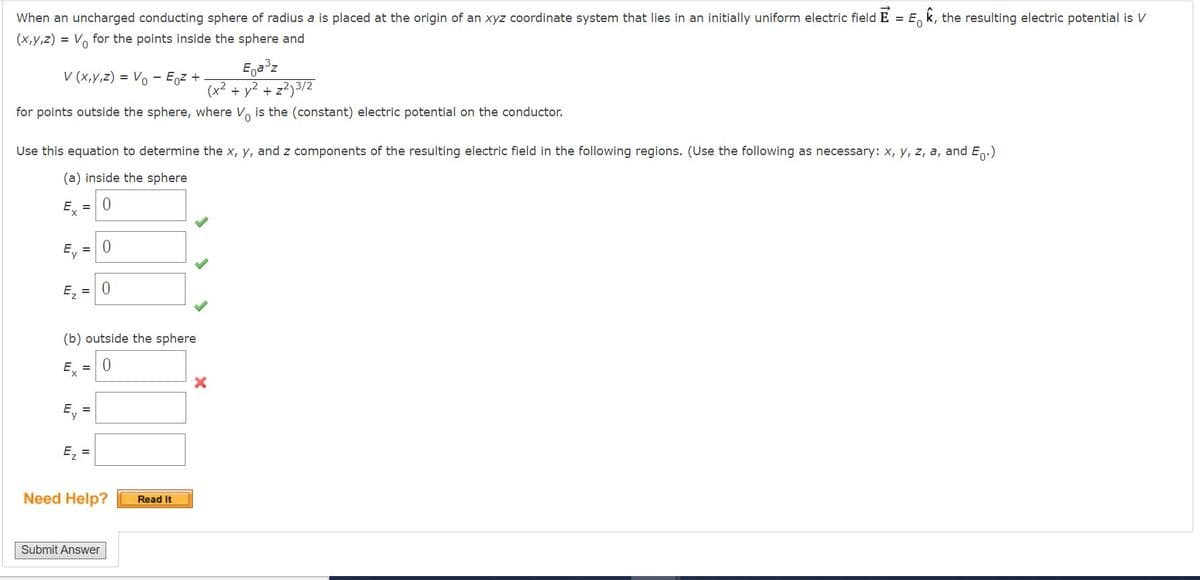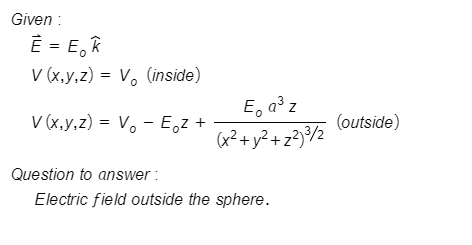When an uncharged conducting sphere of radius a is placed at the origin of an xyz coordinate system that lies in an initially uniform electric field = E0 , the resulting electric potential is V (x,y,z) = V0 for the points inside the sphere and V (x,y,z) = V0 − E0z + E0a3z (x2 + y2 + z2)3/2 for points outside the sphere, where V0 is the (constant) electric potential on the conductor. Use this equation to determine the x, y, and z components of the resulting electric field in the following regions. (Use the following as necessary: x, y, z, a, and E0.) (a) inside the sphere (b) outside the sphere Note: I already solved part a. I need help with part b. Look at the image for the full problem
When an uncharged conducting sphere of radius a is placed at the origin of an xyz coordinate system that lies in an initially uniform electric field = E0 , the resulting electric potential is V (x,y,z) = V0 for the points inside the sphere and V (x,y,z) = V0 − E0z + E0a3z (x2 + y2 + z2)3/2 for points outside the sphere, where V0 is the (constant) electric potential on the conductor. Use this equation to determine the x, y, and z components of the resulting electric field in the following regions. (Use the following as necessary: x, y, z, a, and E0.) (a) inside the sphere (b) outside the sphere Note: I already solved part a. I need help with part b. Look at the image for the full problem
Physics for Scientists and Engineers: Foundations and Connections
1st Edition
ISBN:9781133939146
Author:Katz, Debora M.
Publisher:Katz, Debora M.
Chapter26: Electric Potential
Section: Chapter Questions
Problem 45PQ: The charge density on a disk of radius R = 12.0 cm is given by = ar, with a = 1.40 C/m3 and r...
Related questions
Question
When an uncharged
V (x,y,z) = V0 − E0z +
| E0a3z |
| (x2 + y2 + z2)3/2 |
for points outside the sphere, where V0 is the (constant) electric potential on the conductor.
Use this equation to determine the x, y, and z components of the resulting electric field in the following regions. (Use the following as necessary: x, y, z, a, and E0.)
(a) inside the sphere
(b) outside the sphere
Note: I already solved part a. I need help with part b. Look at the image for the full problem.

Transcribed Image Text:When an uncharged conducting sphere of radius a is placed at the origin of an xyz coordinate system that lies in an initially uniform electric field E = E, k, the resulting electric potential is
0.
(x,y,z) = V. for the points inside the sphere and
V (x,y,z) = Vo
Eoz +
Ega z
(x2 + y? + z?)3/2
for points outside the sphere, where V, is the (constant) electric potential on the conductor.
Use this equation to determine the x, y, and z components of the resulting electric field in the following regions. (Use the following as necessary: x, y, z, a, and E.)
(a) inside the sphere
E = 0
Ey
E, = 0
(b) outside the sphere
Ex =0
Ey =
E =
Need Help?
Read It
Submit Answer
Expert Solution
Step 1

Trending now
This is a popular solution!
Step by step
Solved in 4 steps with 4 images

Knowledge Booster
Learn more about
Need a deep-dive on the concept behind this application? Look no further. Learn more about this topic, physics and related others by exploring similar questions and additional content below.Recommended textbooks for you

Physics for Scientists and Engineers: Foundations…
Physics
ISBN:
9781133939146
Author:
Katz, Debora M.
Publisher:
Cengage Learning

Principles of Physics: A Calculus-Based Text
Physics
ISBN:
9781133104261
Author:
Raymond A. Serway, John W. Jewett
Publisher:
Cengage Learning

Physics for Scientists and Engineers, Technology …
Physics
ISBN:
9781305116399
Author:
Raymond A. Serway, John W. Jewett
Publisher:
Cengage Learning

Physics for Scientists and Engineers: Foundations…
Physics
ISBN:
9781133939146
Author:
Katz, Debora M.
Publisher:
Cengage Learning

Principles of Physics: A Calculus-Based Text
Physics
ISBN:
9781133104261
Author:
Raymond A. Serway, John W. Jewett
Publisher:
Cengage Learning

Physics for Scientists and Engineers, Technology …
Physics
ISBN:
9781305116399
Author:
Raymond A. Serway, John W. Jewett
Publisher:
Cengage Learning


Classical Dynamics of Particles and Systems
Physics
ISBN:
9780534408961
Author:
Stephen T. Thornton, Jerry B. Marion
Publisher:
Cengage Learning

College Physics
Physics
ISBN:
9781285737027
Author:
Raymond A. Serway, Chris Vuille
Publisher:
Cengage Learning